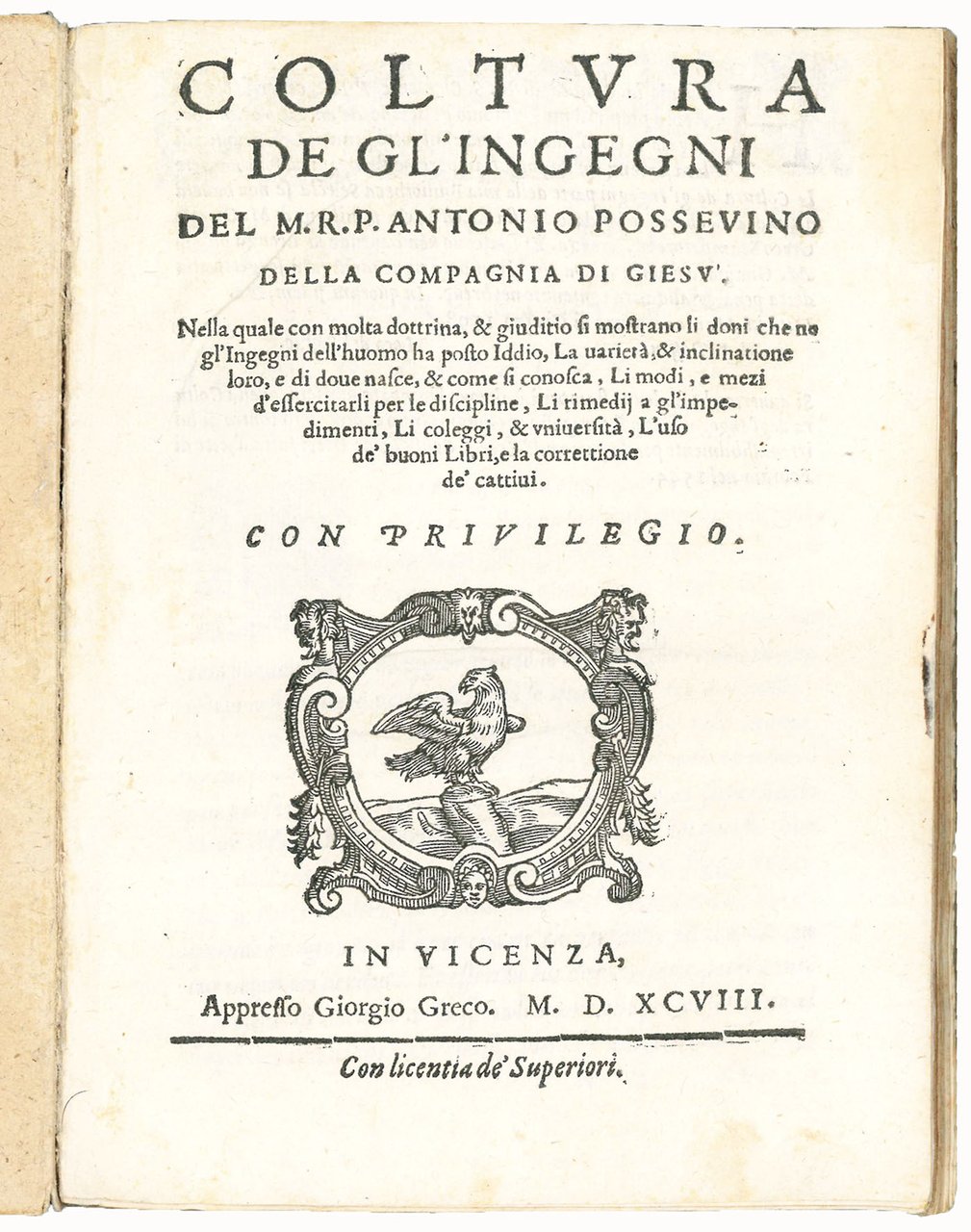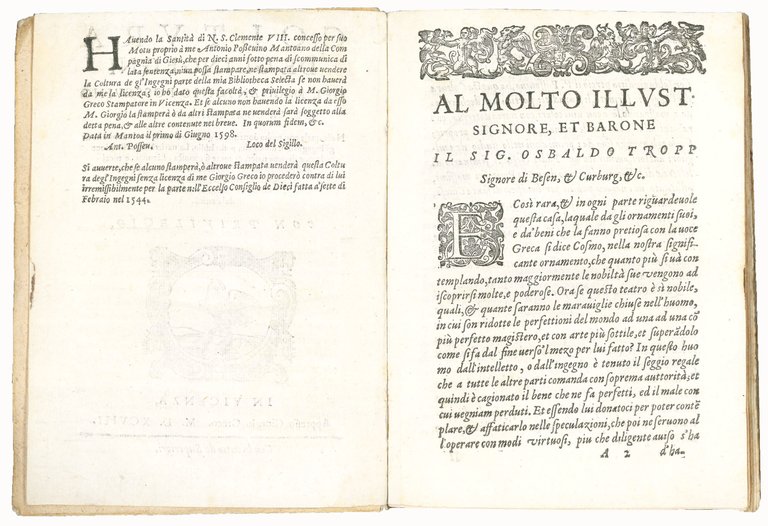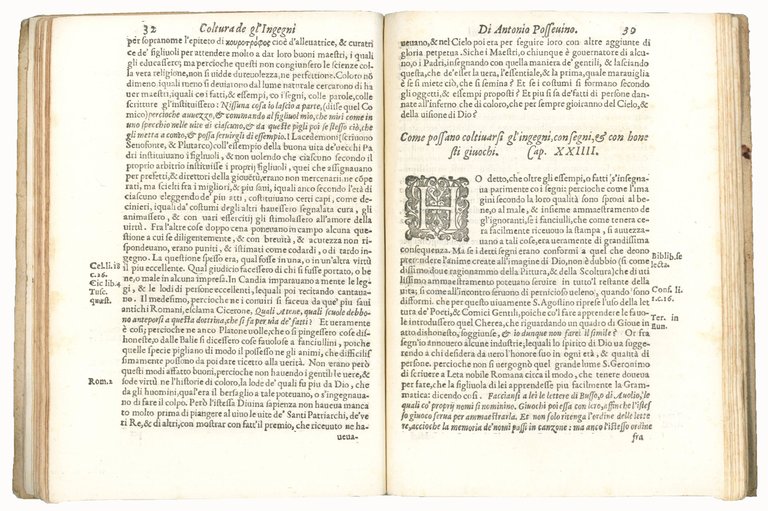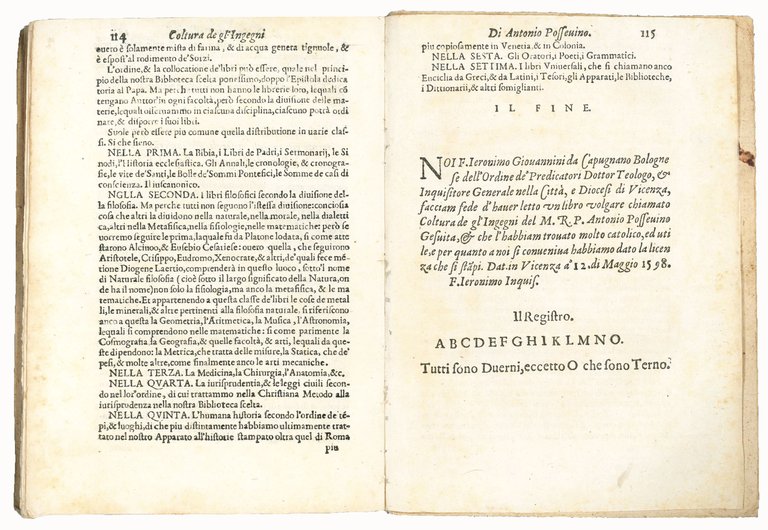




Livres anciens et modernes
POSSEVINO, Antonio (1533-1611)
Coltura de gl'ingegni del M.R.P. Antonio Possevino della Compagnia di Giesù. Nella quale con molta dottrina, et giuditio si mostrano li doni che ne gl'ingegni dell'huomo ha posto Iddio, la varietà, et inclinatione loro, e di dove nasce, et come si conosca, li modi, e mezi d'essercitarli per le discipline, li rimedij a gl'impedimenti, li coleggi, et università, l'uso de' buoni libri, e la corretione de' cattivi
Giorgio Greco, 1598
1500,00 €
Govi Libreria Antiquaria
(Modena, Italie)
Les frais d'expédition corrects sont calculés une fois que l'adresse de livraison a été indiquée lors de la création de la commande. Un ou plusieurs modes de livraison sont disponibles à la discrétion du vendeur : standard, express, economy, in store pick-up.
Conditions d'expédition de la Librairie:
Pour les articles dont le prix est supérieur à 300 euros, il est possible de demander un plan de paiement échelonné à Maremagnum. Le paiement peut être effectué avec Carta del Docente, Carta della cultura giovani e del merito, Public Administration.
Les délais de livraison sont estimés en fonction du temps d'expédition de la librairie et de la livraison par le transporteur. En cas de retenue douanière, des retards de livraison peuvent survenir. Les frais de douane éventuels sont à la charge du destinataire.
Pour plus d'informationsMode de Paiement
- PayPal
- Carte bancaire
- Virement bancaire
-
-
Découvrez comment utiliser
votre Carta del Docente -
Découvrez comment utiliser
votre Carta della cultura giovani e del merito
Détails
Description
First Italian translation of the first twelve chapters of the first book of Possevino's famous Bibliotheca selecta (1593). This part was to become the most diffused; however, a Latin edition appeared only in 1604. The translation, done by Possevino himself, is divided into fifty-six chapters, each with an individual title to facilitate the reading and the finding of the various topics. Possevino had passed the manuscript to Mariano Lauretti, who published it with a dedication to Baron Oswald Trapp. In the privilege Possevino states that he ceded the license to print the work to the typographer Giorgio Greco of Vicenza (cf. L. Balsamo, Venezia e l'attività editoriale di Antonio Possevino (1553-1606), in: “La Bibliofilia”, XCIII/1, Florence, 1991, pp. 65-66, 88).
More detailed and radical than the Jesuit Ratio studiorum, which was more or less only a collection of official directions regulating the curriculum, Possevino in his Coltura de gl'ingegni (‘Cultivation of the Intellectual Faculties') clearly defines the aims and means of education, and the obstacle to it. The aims are wisdom and religion; the means the physical strength, the intellectual powers as well as teachers and books; the obstacle originates from sin, which greatly diminishes the intellectual powers. Differently from the ancient philosophers the ultimate purpose of life is not the acquisition of virtue, but the God of Christendom. This can be reached by proper education of the intellectual powers. Possevino therefore offers a detailed curriculum, describes several European universities, gives a vivid illustration of the teaching in the Collegio Romano, and also discusses printing, selling and the keeping of books in a library, censorship, etc. (cf. G. Fell, ed., Pädagogische Schriften von Antonio Possevin, Freiburg i.Br., 1901, pp. 368-391).
Of great interest are also the chapters in which Possevino points to the fact that teachers should take into consideration the individual inclination of their students to help them to better develop their capacity of learning and their talents. “Zu dem umfassenden Schrifttum, das jene Bildungsauffassung in ihrer universalen Ausrichtung dokumentiert, gehört jener erste Teil der Bibliotheca Selecta, den Possevino 1598 in Vicenza in einer gesonderten Ausgabe unter dem Titel Coltura de gl'ingegni erscheinen liess. Es geht darin umfassend um die ‘doni che ne gl'Ingegni dell'huomo ha posto Iddio'. Diese Wissensgaben, deren Mannigfaltigkeit und deren Ausrichtungen (‘inclinationi'), werden gemäss der Widmungsadresse von Mariano Lauretti als ‘Cosmo' ganzheitlich gefasst. Wer sich mit diesem Kosmos befasst, entdeckt dessen ganzen Reichtum, der sich als ein nobles ‘teatro' darstellt und dem die ‘maraviglie chiuse nell'huomo' entsprechen. Der ‘intelletto' und der ‘ingegno' halten diesen Reichtum zusammen. Sie sind dem Menschen deshalb eingegeben, ‘per poter contemplare, et affaticarlo nelle speculazioni, che poi ne servono all'operare con modi virtuosi' ” (W. Oechslin, Architektur als “Scienza speculativa”, in: “Architettura è scienza. Vincenzo Scamozzi (1546-1616)”, Vicenza, 2003, p. 23ff).
Antonio Possevino was born at Mantua to a family of goldsmiths. After a humanist education he served as tutor to two Gonzaga princes, both future cardinals. He entered the Jesuits in 1559 and spent several years in France as preacher, writer and superior, mainly at Lyons and Avignon. From 1573 to 1577 he was secretary to the Jesuit general Everard Mercurian in Rome. Pope Gregory XIII sent Possevino as nuncio to Sweden, where John III was inclining toward Catholicism. After John III reconsidered, Possevino was sent to Moscow. He did help establish six papal seminaries in Poland-Lithuania, Moravia and Transylvani

